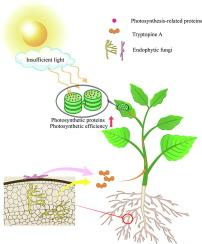Fungus-derived opine enhances plant photosynthesis
IF 11.4
1区 综合性期刊
Q1 MULTIDISCIPLINARY SCIENCES
引用次数: 0
Abstract
Introduction
Plant-fungal interactions stimulate endophytic fungi to produce a plethora of metabolites that enhance plant growth and improve stress resistance. Opines, naturally occurring compounds formed through the condensation of amino acids with α-keto acids or sugars, have diverse biological functions and are mainly present in bacteria. Interestingly, investigations have revealed the presence of opine synthases (OSases) in fungal species as well, and their functions are yet to be studied.Objectives
The objective of this study is to investigate the occurrence of OSases in fungal species, identify their products, and characterize the potential biological activity of the metabolites.Methods
We identified a putative class of OSases in fungi through sequence similarity network (SSN) analysis. The function of these enzymes was elucidated using methods including protein heterologous expression, in vitro biochemical characterization, in vivo gene knock-out, as well as product isolation and identification. Additionally, we conducted plant activity testing on the secondary metabolites through foliar spraying and performed transcriptomic analysis to uncover their functions.Results
A quarter of the PF18631 family members, which contain the C-terminal helical bundle domain of cucumopine synthase, are derived from endophytic fungi. Some of these enzymes catalyze the synthesis of tryptopine A (1-acetyl-3-carboxy-β-carboline) by condensing L-tryptophan and methylglyoxal. The tryptopine A can act as a growth regulator, promoting plant growth and transcriptionally reprogramming photosynthesis-related pathways, while enhancing the rate of plant photosynthesis by 25 %.Conclusion
The findings of this study suggest that tryptopine A plays a crucial role as a signaling molecule in the establishment and maintenance of mutualistic associations between endophytic fungi and host plants, thereby enhancing our comprehension of fungal-plant symbiosis.

从真菌中提取的蛋白氨能增强植物的光合作用
引言 植物与真菌的相互作用会刺激内生真菌产生大量代谢产物,从而促进植物生长并提高抗逆性。蛋白氨是氨基酸与α-酮酸或糖缩合形成的天然化合物,具有多种生物功能,主要存在于细菌中。有趣的是,研究发现真菌中也存在蛋白氨酸合成酶(OSases),但它们的功能还有待研究。方法我们通过序列相似性网络(SSN)分析确定了真菌中一类推定的 OSases。我们采用蛋白质异源表达、体外生化鉴定、体内基因敲除以及产物分离和鉴定等方法阐明了这些酶的功能。此外,我们还通过叶面喷洒对次生代谢物进行了植物活性测试,并进行了转录组分析,以揭示其功能。结果 PF18631 家族的四分之一成员来自内生真菌,它们含有葫芦巴碱合成酶的 C 端螺旋束结构域。其中一些酶通过缩合 L-色氨酸和甲基乙二醛,催化色氨酸 A(1-乙酰基-3-羧基-β-咔啉)的合成。本研究结果表明,色氨酸 A 在内生真菌与寄主植物之间建立和维持互惠关系的过程中作为一种信号分子发挥着至关重要的作用,从而加深了我们对真菌与植物共生关系的理解。
本文章由计算机程序翻译,如有差异,请以英文原文为准。
求助全文
约1分钟内获得全文
求助全文
来源期刊

Journal of Advanced Research
Multidisciplinary-Multidisciplinary
CiteScore
21.60
自引率
0.90%
发文量
280
审稿时长
12 weeks
期刊介绍:
Journal of Advanced Research (J. Adv. Res.) is an applied/natural sciences, peer-reviewed journal that focuses on interdisciplinary research. The journal aims to contribute to applied research and knowledge worldwide through the publication of original and high-quality research articles in the fields of Medicine, Pharmaceutical Sciences, Dentistry, Physical Therapy, Veterinary Medicine, and Basic and Biological Sciences.
The following abstracting and indexing services cover the Journal of Advanced Research: PubMed/Medline, Essential Science Indicators, Web of Science, Scopus, PubMed Central, PubMed, Science Citation Index Expanded, Directory of Open Access Journals (DOAJ), and INSPEC.
 求助内容:
求助内容: 应助结果提醒方式:
应助结果提醒方式:


